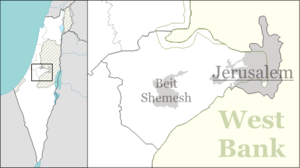Kiryat Anavim
| Kiryat Anavim קִרְיַת עֲנָבִים | |
|---|---|
| Hebrew transcription(s) | |
| • official | Qiryat Anavim |
|
First kibbutz building - a dairy barn, built in 1920 | |
 Kiryat Anavim | |
| Coordinates: 31°48′38.52″N 35°7′11.64″E / 31.8107000°N 35.1199000°ECoordinates: 31°48′38.52″N 35°7′11.64″E / 31.8107000°N 35.1199000°E | |
| District | Jerusalem |
| Council | Mateh Yehuda |
| Affiliation | Kibbutz Movement |
| Founded | 1920 |
| Founded by | Third Aliyah immigrants |
| Population (2015)[1] | 466 |
| Website | kiryatanavim.com |
Kiryat Anavim (Hebrew: קִרְיַת עֲנָבִים, lit. City of Grapes) is a kibbutz in the Judean Hills of Israel. It was the first kibbutz established in the Judean Hills.[2] It is located west of Jerusalem, and falls under the jurisdiction of the Mateh Yehuda Regional Council. In 2015 it had a population of 466.
History

The land on which the kibbutz stands was purchased from the neighboring village of Abu Ghosh. In 1912 the Abu Ghosh family sold thousands of dunams to Arthur Ruppin, who represented the Zionist movement.[3] In 1919 a group of 6 pioneers from the Ukrainian town of Kaminiz Podolsk and Preluki settled on the land, near a small spring called "Dilb" so-called for the surrounding plane trees (Arabic: dilb; Hebrew: dolev).[4] The other 20 arrived there in spring of 1920 while five of the group came in December 1920 after liquidation of the farm in Odessa where they learned to become farmers.
In the 1922 census of Palestine conducted by the British Mandate authorities, Qiriath Anavim had a population of 73, all Jews.[5] Increasing in the 1931 census to 109, in 29 houses.[6]
By the end of 1920, there were 200 pioneers on the kibbutz.
During Hanukkah 1925, a group of Hebrew writers convened at Kiryat Anavim to discuss creative ways of promoting the land reclamation and settlement work of the Jewish National Fund. The conference expressed the hope that Jewish authors and intellectuals in the Diaspora would help to further this cause.[7]
The Gordonia group arrived from Galicia, Poland in 1936.
On 9 November 1937, five members of the Gordonia group working on a Jewish National Fund afforestation project near Kiryat Anavim were ambushed and murdered by Arabs. Kibbutz Ma'ale HaHamisha (lit. Hill of the Five), established a year later, was named for them.[8]
During "The Hunting Season", Kiryat Anavim served as a base for the Haganah.[9]
In the 1948 Arab-Israeli War, the 4th Battalion of the Palmach (Harel Brigade), with Uzi Narkiss, mounted their fight for Sha'ar HaGai, the road to Jerusalem, and the city itself, from Kiryat Anavim.[10] Kiryat Anavim and the adjacent Ma'ale HaHamisha were the site of a battle for Mount Hagana between the Palmach (including troops that retreated from the Radar Hill) and the Transjordanian Arab Legion.[11]
On 6 September 1996, a fire in the Jerusalem corridor caused extensive damage in Kiryat Anavim and surroundings. Fifteen homes and 10 other buildings were damaged in the blaze.[12]
Economy
In the early days, the pioneers operated a dairy and a poultry farm. In 1968, the kibbutz produced cherries, peaches, grapes, and plums; and operated a guest house, cotton fields and orange groves. Anavid Insulation Products, founded in 1981, is wholly owned by Kibbutz Kiryat Anavim. The plant produces thermal insulation and sealing materials.[13]In June 2013, the kibbutz opened the Cramim hotel which offers a spa treatment based on vinotherapy.[14]
Landmarks
During the 1948 Arab–Israeli War, many who fell in battle to secure the road to Jerusalem were buried at the kibbutz cemetery. A memorial monument was designed for the cemetery by Israeli sculptor Menahem Shemi. Soldiers of the Harel Brigade are among those interred here.[15]
References
- ↑ "List of localities, in Alphabetical order" (PDF). Israel Central Bureau of Statistics. Retrieved 16 October 2016.
- ↑ Our History Kiryat Anavim
- ↑ Army of shadows: Palestinian collaboration with Zionism, 1917 – 1948 / Hillel Cohen
- ↑ Flowers in Israel
- ↑ Barron, J. B., ed. (1923). Palestine: Report and General Abstracts of the Census of 1922. Government of Palestine. p. 14.
- ↑ Mills, 1932, p. 42
- ↑ Keren Kayemeth, Third Decade
- ↑ Lessons and Legacies I: The Meaning of the Holocaust in a Changing World, edited by Peter Hayes
- ↑ "The "Hunting Season"". etzel.org.il. Retrieved 2008-12-13.
- ↑ A defender of Jerusalem The Jerusalem Post
- ↑ Yitzhaki, Aryeh (1988), A Guide to War Monuments and Sites in Israel, p. 59
- ↑ Israeli Fire Destroys 40 Homes; Allegations of Poor Response SNS Special Report, 8 September 1996
- ↑ Anavid Insulation Products
- ↑ More five-star hotels for Israel The Jewish Chronicle
- ↑ Warriors' Final Resting Place: The Cemetery at Kibbutz Kiryat Anavim Gems in Israel, April 2000
Further reading
- Ed. Aviva Ufaz, Sefer Hachayim, the Diary of Kiryat Anavim, Yad Ben Zvi, 2001 (Hebrew)
- 'Vehigadta Lebinha - 50 Years of Independence', Kiryat Anavim, 1998 (Hebrew)
- 'Sipurei Kibbutzim' (Stories of Kibbutzim), Edited by Zeev Aner, Israel Ministry of Defense, 1998, ISBN 978-965-05-0946-0 (Hebrew)
- 'Document and Fiction of the Third Aliya', written by Aviva Ufaz, Hakibbutz Hameuchad, 1996 (Hebrew)
